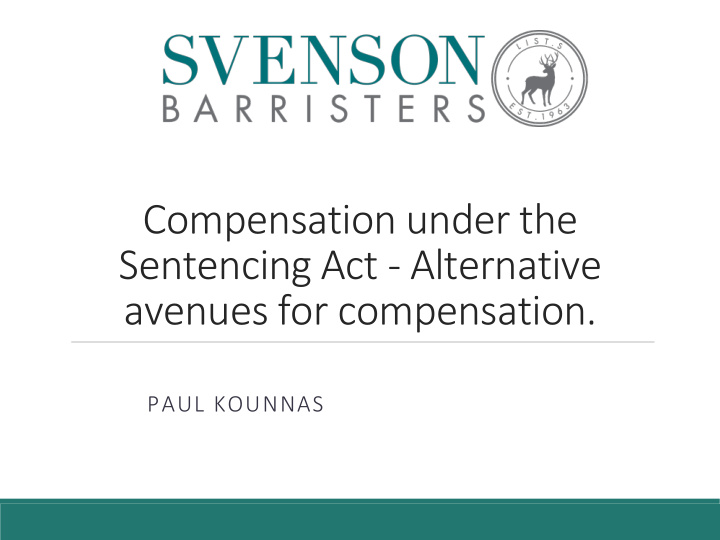



Compensation under the Sentencing Act - Alternative avenues for compensation. PAUL KOUNNAS
Statutory Scheme Source of the Power: s85 B Sentencing Act (Compensation Claims) s84 Sentencing Act (Restitution Order)
Avenues for Compensation (following a crime) 1. Common Law Generally 2. VOCAT 3. s85 Applications
Who can make an application A person suffering an injury as a DIRECT result of a crime Includes an offence wrapped up in a ‘representative’ count.
Time Limits 12 months from the date of conviction. Made to the Sentencing Judge or Magistrate. If they have retired - then the listing judge or supervising Magistrate. Previous VOCAT application no bar.
INJURY! What is an injury? Broadly defined. Includes Physical or Psychiatric (& Psychological) injury. Seemingly also includes grief and distress (usually considered as a ‘head’ for compensation - the authority is unclear)
What can be compensated? • Anything caused as a direct result of the injury. • Direct has a different meaning to causation in tort. • Also as a result of a ‘representative’ charge where the injury is from one of the non particularised charges. • Anything flowing from that injury including ancillary matters • NOT clothes or personal effects (VOCAT) • NOT economic/non economic loss (Wrongs Act)
What is this application? NOT a civil application. An application in a Criminal Matter. Civil burdens of proof apply (to causation) Civil Procedure does not apply. Procedural Fairness does.
How is the Application made • Must be made to the sentencing Judge • Within 12 months of the conviction (finding of guilt) • Can be made on behalf of a victim
What Information Application must include the following: A. Applicant’s age and date of birth B. the injury for which compensation is being sought including particulars of that injury C.the offence which directly resulted in the incurring of the claimed injury D.Particulars of costs and expenses which the applicant seeks to recover E. a copy of the crown opening F. a copy of the sentencing remarks G.any medical expenses (claimed under s85A) H.VOCAT award if completed I. A list of the lay experts or experts to be relied upon J. Any other essential miscellaneous documents; and K. An address for service.
Category C: the offence What details do you need? All primary material; Police summary or Crown opening VIS Witness Statements Sentencing Remarks (or transcript from Magistrates’ Court)
Application: • To set out basis for compensation • To set out finding of the court and when • To set out injury suffered • To include any specialists reports • To set out any other circumstances relevant • NOT to be a statement of claim • NOT to be full pleadings in another form
Response if Served: Must be in writing Must set out short response and defence to claim if any Must set out witnesses required for examination Must include a short statement of financial circumstances Must include any experts Must include an address for service.
Process & Timetabling 1. Application made 2. Response prepared 3. First Mention or Directions - Any Timetabling orders made. 4. Any subsequent Directions 5. Hearing (before single Judge or Magistrate)
What can we expect? These are NOT damages. Meant to be Compensation for Injury. Reality is it has grown beyond that. Meant to be ‘Quick and Easy’
So How Much ?? • Said to be decided on ‘common law principles’ • Depends on Circumstances and Injury • Depends on type of offending • Can be paid in Instalments or otherwise as the court determines • MUST take into account VOCAT award.
What Can be Compensated More than the common law allows. Anything connected to the injury (including matters not entirely proximate) Grief and Distress Pain and Suffering (broader than the common law)
Costs: Generally parties bear their own HOWEVER It is discretionary and in circumstances where Counsel is appropriate or necessary to be engaged, reasonable costs will follow.
The Law: What is a DIRECT result of a crime. Kaplan v Lee Archer 2007
The Law: (Unscrambling the Egg) Watts v Rake Respondent’s onus to disentangle causation of injury once proven.
The Law: (Civil v Criminal) R K v Mirik & Mirik Meant to be a simple means. Natural Justice Does not affect Civil claim When is it appropriate to reduce the amount awarded?
Preparation: Especially if unfamiliar with criminal law, ensure to obtain the correct documents from the correct prosecuting agency. Ensure experts reports identify causation, or if for respondent, disentangle multiple causes if possible. Ensure not to ask the one question too many (you don’t want a client disclosing further offending!)
Questions?
Recommend
More recommend